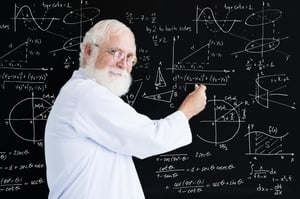The Equation to Determine the Sustainability of Your Retirement Plan
 As a soon-to-be or recent retiree, your goal is to ensure a successful, happy retirement and avoid running out of money.
As a soon-to-be or recent retiree, your goal is to ensure a successful, happy retirement and avoid running out of money.
Two pressing questions that will determine your circumstances are:
- How long can you live and support yourself (and your family) until the nest egg empties?
- What is the financial strategy behind a sustainable retirement plan?
Author and New York University Professor, Moshe Milevsky, wrote the book, “The 7 Most Important Equations for Your Retirement.” In his book, he used seven mathematical equations to address seven areas that impact financial security in retirement.
The Retirement Sustainability Equation
To address the question of sustainability, Milevsky leaned on the unified equation created by the Russian mathematician, Andrei Nikolaevich Kolmogorov.
This equation uses these five factors:
- Your age
- Current asset allocation
- Pension income
- Longevity
- Other things on your balance sheet
Milevsky wrote that the equation, “states the ruin probability multiplied by the instantaneous force of mortality must be exactly equal to the sum of three distinct terms.”
Milevsky’s high-level explanation may be challenging to apply to your personal retirement situation, but here is an example that puts the equation to work.
Let’s say you are 65 years old and you have $500,000 in your nest egg with an expected rate of return of 4.70 percent, and you plan to spend $25,000 per year in retirement.
After using those numbers and applying the unified equation, you would find out that you have a 25.19 percent chance of running out of money before you die. If those aren’t odds that you want to bet on, then use Kolmogorov’s equation and adjust some of the numbers.
In this case, if you haven’t reached 65 yet, you can work to adjust the size of your nest egg. If that’s not a possibility, then you have to adjust the other way and reduce your yearly spending. By adjusting either factor, the probability of running out of money will decrease.
Historical Math Can Answer Your Retirement Questions
In addition to this equation, Milevsky also uses historical math equations to show other factors that affect your retired life. For instance, he uses Edmond Halley’s equation to determine if a pension annuity is worth the investment, and Paul Samuelson’s to show the risk involved in stock investments versus safe cash. He also addresses how to evaluate your financial legacy, and a few other retirement-related questions.
Although these equations may seem complicated on paper, Milevsky’s reasoning and explanations show that the math does not lie and that these equations can be very telling about the future of your finances.

